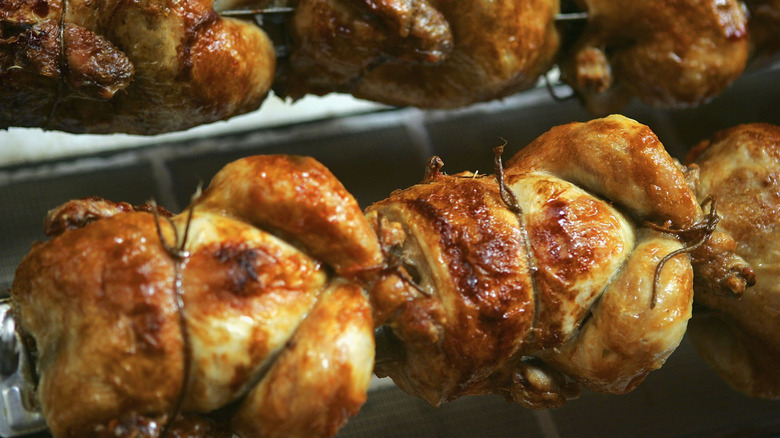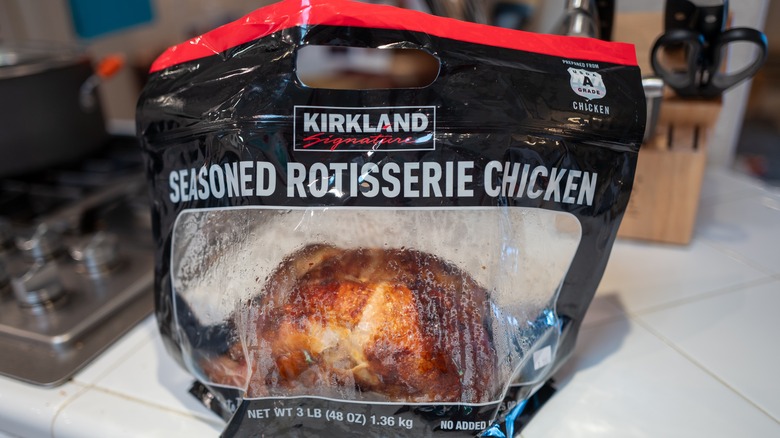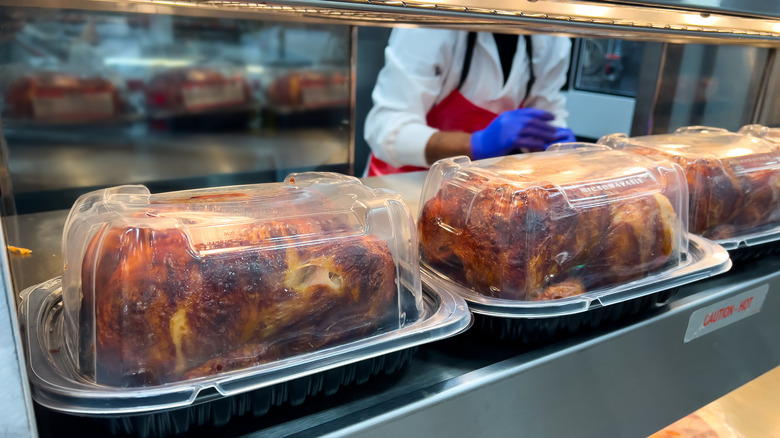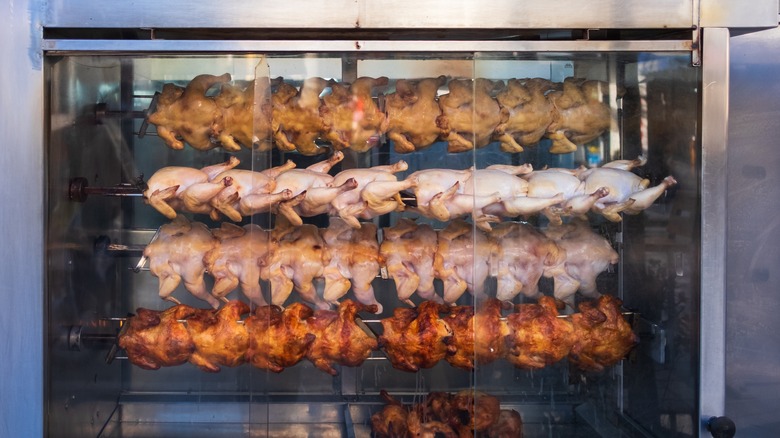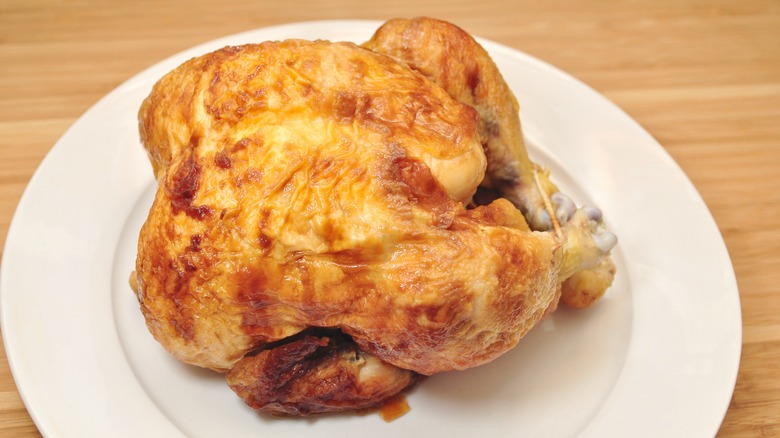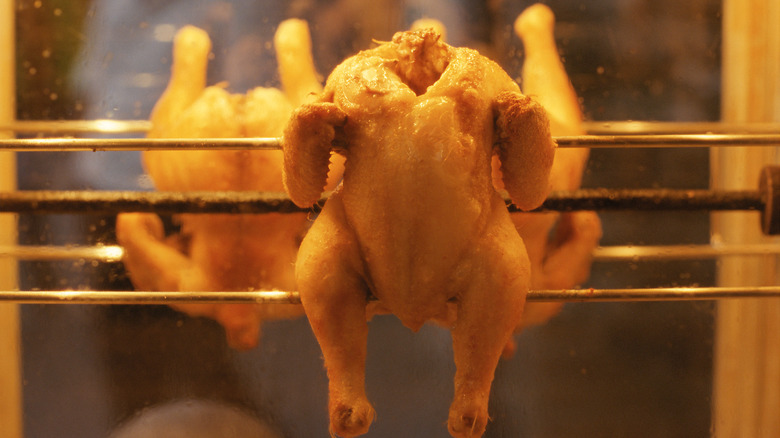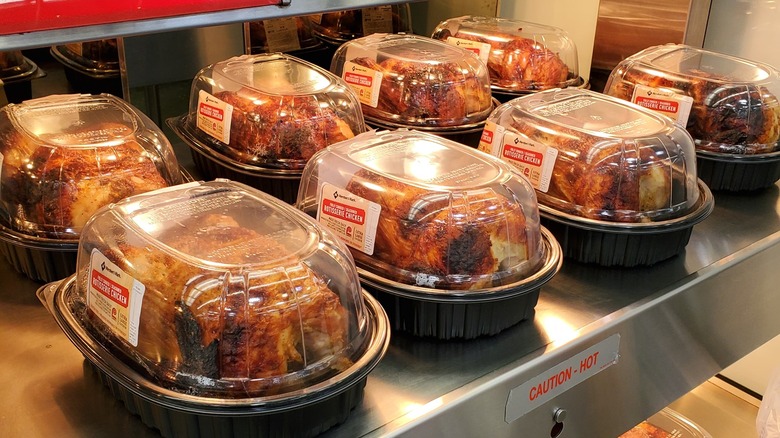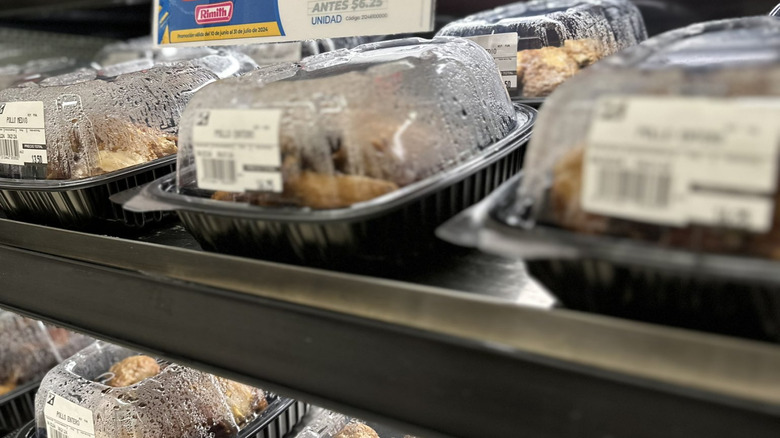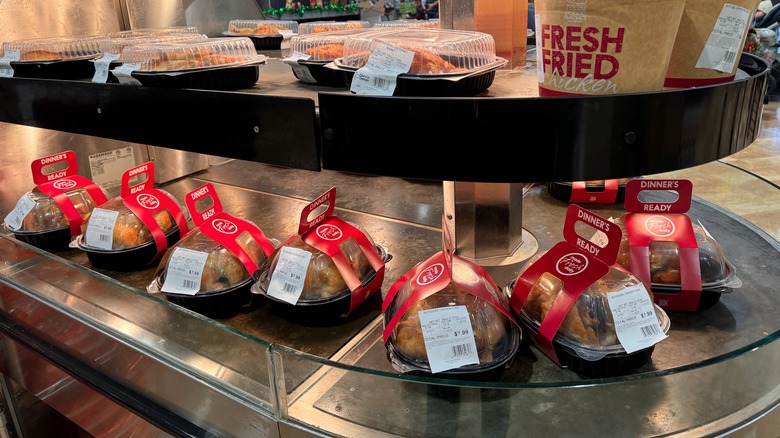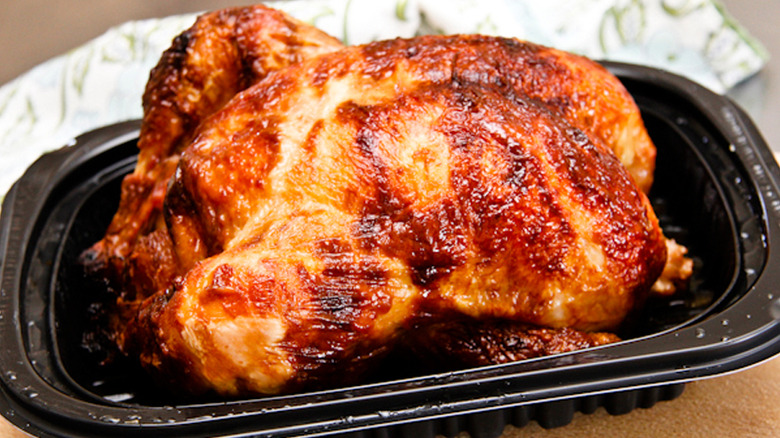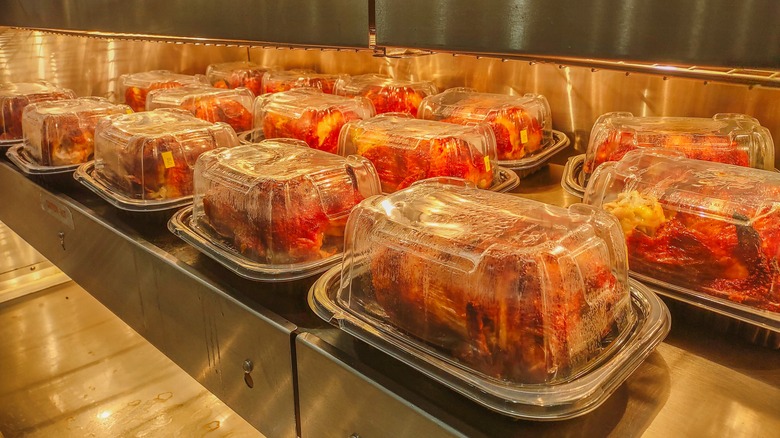11 Things You Should Pay Attention To When Buying A Rotisserie Chicken
Protein doesn't come much easier, tastier, or more cost-effective than a rotisserie chicken. From Costco (which has famously managed to keep its birds to just $5 apiece) to Whole Foods, there's no shortage of grocery stores out there spit-roasting poultry throughout the day. There's also no shortage of demand. In fact, our hunger for fresh, hot chicken-to-go seems to be growing; Costco alone sold 137 million birds in 2023, an increase of 17 million on the previous year.
The only downside of rotisserie chicken is that no two birds are exactly alike. A sad reality is that it's more than possible to stumble upon a dry, bland, or overly processed chicken in an otherwise stellar store. It takes a well-trained eye to separate the tastiest rotisserie chickens from the not-so-tasty on sight but, fortunately for you, we've put together the ultimate guide to doing so.
We consulted two bona fide rotisserie chicken experts – Scott Groth and Meggan Hill, both of whom are trained chefs and food bloggers — to discover what to look out for when choosing our chicken. From the texture of its skin to the time of day you get your groceries, more goes into picking the juiciest, most flavorful meat than you'd think. Keep a close eye on these 11 details to nail your next rotisserie chicken purchase.
The skin can tell you a lot about the juiciness of a rotisserie chicken
We're not supposed to judge a book by its cover, but when it comes to rotisserie chicken, you may want to let that proverbial tidbit slide. The state of each bird's skin can tell you a lot about what to expect from the texture of the meat. Telltale signs that it may be overcooked or dry include skin that looks thin or isn't entirely intact. As per Meggan Hill — a classically-trained chef living in California who shares her foodie expertise on her blog Culinary Hill — a dry chicken "may have skin that appears dry on the surface or is tearing in places from too much tension."
Confusingly, even chickens that don't look dry on the outside may still totally different once you tuck into the actual meat. When inspecting the birds on offer, chef Scott Groth — who runs the food blog I'd Rather Be A Chef — also suggests avoiding those with skin that looks rubbery or overly wet. "This indicates that it has been holding for quite some time in the warming tray, which could also indicate dry meat," Groth explains.
The perfect rotisserie chicken falls somewhere in between Hill and Groth's red flags. In Hill's words, the right bird will boast "skin that looks moist to the touch, gently clinging to the meat beneath but not wrinkling or being stretched too tightly." Find one that meets that description and you're golden.
A large amount of inventory may be a red flag
The luxury of choice isn't always a good thing. If you find yourself poring over a huge number of rotisserie chickens at the deli counter, that in itself can be a red flag. On the most basic level, a huge amount of stock means the chicken isn't tasty enough to be popular. "If their rotisserie chickens are frequently selling out, it's a good sign they're using higher-quality birds and have mastered the seasoning and cooking process," says Meggan Hill.
Scott Groth shares Hill's concerns about overstocked deli counters. "It's a sign that this store either uses chicken that is lower in quality or doesn't know how to cook it properly," he says. The reality is that high-quality chicken is expensive. Poultry costs reached a record high in 2023 and the price of a whole chicken increased by another 0.7% between November 2023 and November 2024, as per the U.S. Bureau of Labor Statistics.
If a store cooks rotisserie chickens en masse, even with low demand, that suggests the chicken may be so cheap or low quality that their unpopularity is inconsequential. As Groth adds, some stores have other motivations for cooking so many chickens at once. Just as customers often use leftover rotisserie chicken to prep other meals, grocery stores often use the leftover rotisserie chicken to "make chicken salads and other prefab food sold at the deli counter," which means they will continue to make them despite low sales.
The time of day may impact the chicken's quality
Technically, you can pick up a rotisserie chicken from your local store at pretty much any time of day, but if you want to secure the freshest rotisserie chicken possible, you may want to start being more intentional with when you swing by the deli counter. While most stores cook chickens all day long, they know when the masses are most likely to come sniffing, and often cook the right quantity accordingly.
That's why "timing is key," in the words of Scott Groth. "Chickens are typically at their freshest around noon and 6 p.m.," he says. "Grocery stores often add chickens to the rotisserie between 10 and 11 a.m. to have them ready for the lunchtime rush, and again between 4 and 5 p.m. for the dinner crowd." At Costco, it's also worth listening out for the bell, which employees use to announce a freshly cooked batch.
Of course, planning your day around picking up a rotisserie chicken is easier said than done. Not everyone has the flexibility to squeeze in a late afternoon grocery run. However, it's worth noting that if you can't make it until much later on in the evening — by which point many stores have likely pressed pause on cooking fresh chicken — your odds of securing more middling meat increase. "It's likely been sitting in its container for several hours, which can cause it to dry out as the juices drain," warns Groth.
Certain labels are nice to have, but don't always necessarily equal tastier chicken
For some shoppers, labels like "organic" and "all-natural" act as the catalyst that helps them decide whether or not a food product is worth buying. Just don't mistake these labels as a sign that your rotisserie chicken will be superior in terms of taste or texture. The reality is that these labels only indicate how a chicken was raised and make no guarantee on how the final product holds up on the flavor front.
"While chickens with these labels may sometimes be juicier or more flavorful, it ultimately depends on how the bird was raised, processed, seasoned, and cooked," explains Scott Groth. If a chicken is marketed as "natural," for example, all that means in the eyes of the USDA is that it undergoes minimal processing and contains zero colorings or artificial ingredients. Meanwhile, for meat to count as "organic," it must be raised without antibiotics or growth hormones (although the latter isn't too much of an achievement, considering that technically zero hormones are supposed to be used in any poultry produced in the U.S.). Both are commendable attributes, yes, but the reality is that an organic, natural chicken could still end up dry or bland if prepped with the wrong technique.
A long list of flavorings is often a bad sign
Delicious rotisserie chicken doesn't happen by chance. It certainly also doesn't happen by simply sticking raw, plain poultry on a skewer and hoping for the best. A not-so-secret truth about your favorite rotisserie chicken is that it's often injected with a solution composed of water, salt (in some cases, a concerning amount of salt), and a handful of other ingredients to help it retain moisture and maximize juiciness. That means you'll almost always see ingredients other than straight-up meat on the label of your rotisserie chicken.
While Scott Groth acknowledges that you may find extra ingredients listed under the seasoning or brine used for each chicken, what you shouldn't see is a lengthy list of hard-to-pronounce additives that sound better suited to a lab than a supermarket. If you do, it may have a negative impact on the meat's texture. "Oftentimes, grocery stores add flavoring enhancements to inexpensive chickens," says Groth. "If the chicken has a ton of ingredients you don't recognize on the label, it will most likely be dry after it is cooked."
Quantity doesn't always equal quality
Logical though it may seem to automatically grab the heftiest rotisserie chicken the store has to offer, it's worth noting that smaller birds — between 2.5 and 4 pounds — are often better candidates for rotisserie. Thanks to their diminutive size, they cook quicker and more evenly, which makes it easier for stores to standardize quality. "These smaller birds are preferred because larger chickens take longer to cook, which can complicate timing and consistency for stores," explains Scott Groth, who also recommends avoiding chickens that are considerably bigger than others stocked at the deli counter. "If it's an outlier, there's a higher risk it might not have cooked thoroughly, and the last thing you want is to bring home an undercooked chicken."
Meggan Hill is in agreement that bigger isn't always better. "Smaller birds can be tastier because it might indicate they are younger," she says. "Younger chickens often taste better because the meat is more tender due to lower fat in the bird. A small size might also indicate the bird was raised in a more humane environment rather than in a factory farm." While this may generally be the case, Hill stresses that there are always exceptions to the rule. Some smaller rotisserie chickens may offer poor value for money, while some larger chickens may end up being the tastiest of the bunch. This is merely one factor to bear in mind when aiming to buy the best bird possible.
Keep an eye out for condensation inside the container
Theoretically, most stores switch out their rotisserie chickens on a regular basis. At Costco, for example, rotisserie chickens only get two hours before employees swipe them from the shelves and put them towards another purpose, such as shredding the meat and using it in salads or soups. This short lifespan prevents the meat from drying out, meaning every customer takes home the juiciest chicken possible.
If you're unsure how long a chicken has been sitting out under the heating lamp, Scott Groth recommends taking a close look into the packaging (only if it's partially transparent, like the bags used for Costco's rotisserie chickens; grocery store employees won't thank you for ripping into containers of freshly cooked meat) to check for condensation. If there is a clear buildup from the inside, you're probably better off choosing a different chicken. "Condensation inside the container might indicate that the chicken sat in the packaging for too long, which can lead to soggy skin," he says.
Excessive juices may equal a drier rotisserie chicken
Condensation isn't the only red flag potentially lurking inside a container of rotisserie chicken. Excessive juices are another sign that the bird has lost a lot of moisture since sitting out under the heating lamp. It's possible that the chicken itself was just exceptionally succulent, but keep in mind that the longer a bird sits, the more time its juices have to seep out.
While some level of liquid is normal — even desirable, as absolutely zero juices would suggest that the meat was so dry, it had no moisture to lose in the first place — Scott Groth tends to steer clear of any birds sitting in a visible pool. This comes down to more than just lost juices. As Groth says, "If the chicken appears to be swimming in liquid, it might indicate that additional juice has been added to mask dryness."
The chicken should ideally still be hot when you pick it up
While you'd have to time your visit to the deli counter exceptionally well to grab a chicken straight off the rotisserie, your bird should ideally still be hot when it hits your shopping cart. Stores put a lot of effort into keeping their rotisserie chickens toasty for as long as possible — hence why they typically sit under heat lamps — but it's still wise to double-check the temperature before making your purchase.
This has more to do with basic food safety than flavor or texture. As a rule, chicken should be cooked to at least 165 degrees Fahrenheit and then kept at a minimum of 135 degrees Fahrenheit to prevent spoilage. Anything that feels cooler should be avoided. While we don't recommend strutting into the store armed with a meat thermometer (and, most likely, neither would the store itself), Scott Groth has a simple tip for assessing the temperature of your chicken. "You should feel heat radiating from the chicken when you pick it up," he says, as well as suggesting that you check in with staff on the deli counter if you're unsure whether the chicken is hot enough. To keep your chicken warm, Groth also recommends making the deli counter the final stop of your grocery trip. Not only does this keep the chicken hot, but it also prevents other groceries from warming up in your cart.
A golden brown rotisserie chicken will often be the juiciest
The color of a rotisserie chicken's skin serves as a pretty strong indicator of its quality. A quick once-over of the bird's exterior can tell you a lot about how it's been cooked or seasoned. Ideally, you should find that the skin is a relatively even, deep golden brown hue. A darker shade may be a red flag for how the chicken was cooked. "A chicken that is very dark could be burned, so I avoid those," advises Meggan Hill. Overcooking a rotisserie chicken can impact more than just the skin. Should the bird be cooked for too long or at too high a heat, the juices can evaporate, leaving the meat dry, tough, and just plain unenjoyable.
At the same time, Hill avoids any suspiciously pale birds, noting that "this may indicate the chicken is under-seasoned." Groth has another reason for skipping any lackluster-looking chickens. "If the skin looks pale or gray, the chicken might not have been cooked properly," Groth warns. A bland chicken is disappointing enough, but undercooked or raw meat is even worse.
The time spent under the heating element can affect the chicken's texture
A blunt truth is that old chicken often equals dry chicken. It takes less time than you may think for a rotisserie chicken to dry out sat under a heating lamp. For that reason, one of Meggan Hill's biggest priorities when deciding where to buy a bird is finding somewhere that's completely transparent with their timings.
"Find a place that labels chickens when they are put out for sale so you know how long it's been sitting out," she says. "Stick to a store where you can at least determine the freshness of your rotisserie chicken. The big stores such as Sam's Club and Costco both sell hundreds of chickens per day, maybe even thousands, so at least you can count on consistent turnover to know your bird is probably fresh." (Coincidentally, Sam's Club placed first in our ranking of grocery store rotisserie chickens, suggesting it's a reliable choice on all fronts).
Scott Groth has a similar approach to finding the freshest chicken possible. If a store doesn't make it explicitly clear how long meat been available for purchase, don't be shy. Groth encourages you to "find someone in the department who can tell you when the chicken was cooked and put under the heating element to hold." After all, if you don't ask, you don't get.
